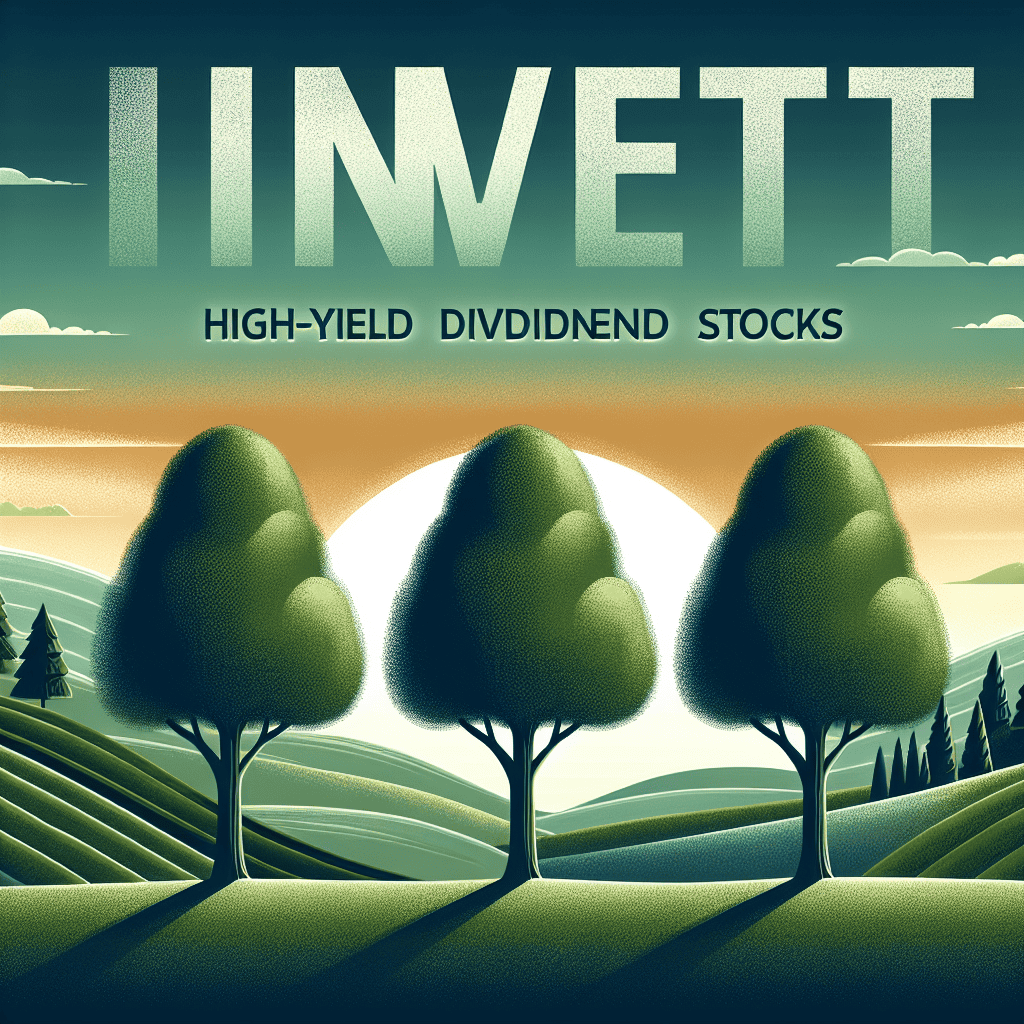“Secure Your Future: Invest in Stability with These Top 3 High-Yield Dividend Stocks.”
Introduction
Investing in high-yield dividend stocks can be a strategic move for those seeking both income and stability in their portfolios. These stocks not only provide regular income through dividends but also have the potential for capital appreciation over time. In an unpredictable market environment, selecting the right dividend stocks can offer long-term peace of mind, ensuring a steady cash flow and reducing overall portfolio volatility. This article highlights three high-yield dividend stocks that stand out for their robust financial health, consistent dividend payouts, and potential for sustainable growth, making them ideal candidates for investors aiming to secure their financial future.
Understanding High-Yield Dividend Stocks: A Path to Financial Security
Investing in high-yield dividend stocks can be a prudent strategy for those seeking financial security and long-term peace of mind. These stocks offer the dual benefits of potential capital appreciation and regular income through dividends, making them an attractive option for investors who prioritize stability and consistent returns. As we delve into the world of high-yield dividend stocks, it is essential to understand their role in a diversified investment portfolio and how they can contribute to financial well-being.
High-yield dividend stocks are shares of companies that pay dividends at a higher rate compared to the average market yield. These dividends are typically distributed from the company’s profits, providing shareholders with a steady income stream. This characteristic makes them particularly appealing to retirees or those looking to supplement their income without selling off their investments. Moreover, reinvesting dividends can compound returns over time, further enhancing the growth potential of one’s portfolio.
One of the primary reasons investors gravitate towards high-yield dividend stocks is their ability to provide a buffer against market volatility. In times of economic uncertainty, these stocks tend to be less volatile than growth stocks, as the regular dividend payments can help offset any declines in share price. This stability is often attributed to the nature of the companies that issue high-yield dividends, which are typically well-established firms with strong cash flows and a history of profitability. Consequently, these companies are better positioned to weather economic downturns, offering investors a sense of security.
Furthermore, high-yield dividend stocks can serve as a hedge against inflation. As the cost of living rises, the purchasing power of fixed-income investments, such as bonds, may diminish. However, companies that consistently increase their dividend payouts can help investors maintain their purchasing power over time. This is particularly true for firms operating in sectors with pricing power, such as utilities or consumer staples, where they can pass on increased costs to consumers without significantly affecting demand.
When considering high-yield dividend stocks, it is crucial to evaluate the sustainability of the dividend payments. A high yield may be enticing, but it is essential to ensure that the company can maintain or grow its dividend over time. This involves analyzing the company’s payout ratio, which is the proportion of earnings paid out as dividends. A lower payout ratio suggests that the company retains enough earnings to reinvest in its operations, reducing the risk of a dividend cut in challenging times.
Among the myriad of high-yield dividend stocks available, three stand out for their robust financial health and commitment to rewarding shareholders. These companies have demonstrated a consistent ability to generate cash flow and have a track record of increasing dividends, making them reliable choices for long-term investors. By incorporating these stocks into a diversified portfolio, investors can enjoy the benefits of regular income and potential capital appreciation, all while mitigating risk.
In conclusion, high-yield dividend stocks offer a compelling avenue for achieving financial security and long-term peace of mind. By providing a steady income stream and acting as a buffer against market volatility and inflation, these stocks can play a vital role in a well-rounded investment strategy. As with any investment, due diligence is essential, but with careful selection, high-yield dividend stocks can be a cornerstone of a secure financial future.
The Benefits of Long-Term Investment in Dividend Stocks
Investing in high-yield dividend stocks can be a prudent strategy for those seeking long-term financial stability and peace of mind. Dividend stocks, particularly those with a history of consistent payouts, offer investors a reliable income stream, which can be especially appealing in volatile market conditions. By focusing on high-yield dividend stocks, investors can potentially enjoy both capital appreciation and regular income, making them an attractive option for long-term investment portfolios.
One of the primary benefits of investing in dividend stocks is the potential for passive income. Unlike growth stocks, which reinvest profits to fuel expansion, dividend stocks distribute a portion of their earnings to shareholders. This distribution can provide a steady income stream, which can be reinvested to purchase additional shares or used to meet living expenses. Over time, the compounding effect of reinvesting dividends can significantly enhance the total return on investment, making it a powerful tool for wealth accumulation.
Moreover, high-yield dividend stocks often belong to well-established companies with strong financial foundations. These companies typically have a track record of profitability and a commitment to returning value to shareholders. As a result, they tend to be more resilient during economic downturns, providing a measure of stability in an investor’s portfolio. This resilience can be particularly reassuring for those who are risk-averse or nearing retirement, as it reduces the likelihood of significant capital loss during market fluctuations.
In addition to providing income and stability, dividend stocks can also offer tax advantages. In many jurisdictions, dividends are taxed at a lower rate than ordinary income, which can enhance the after-tax return on investment. This tax efficiency can be an important consideration for investors in higher tax brackets, as it allows them to retain more of their investment income.
Furthermore, investing in high-yield dividend stocks can serve as a hedge against inflation. As the cost of living rises, companies that consistently increase their dividend payouts can help investors maintain their purchasing power. This is particularly important in periods of high inflation, where the real value of fixed-income investments may erode over time. By selecting dividend stocks with a history of increasing payouts, investors can potentially offset the impact of inflation on their investment returns.
It is also worth noting that dividend stocks can contribute to portfolio diversification. By including a mix of dividend-paying companies from various sectors and industries, investors can reduce their exposure to sector-specific risks. This diversification can enhance the overall risk-adjusted return of a portfolio, providing a more balanced investment approach.
In conclusion, investing in high-yield dividend stocks offers numerous benefits for long-term investors. The combination of passive income, financial stability, tax advantages, inflation protection, and diversification makes them an appealing choice for those seeking to build a robust and resilient investment portfolio. By carefully selecting dividend stocks with a strong track record and a commitment to shareholder returns, investors can enjoy long-term peace of mind and financial security. As with any investment strategy, it is essential to conduct thorough research and consider individual financial goals and risk tolerance before making investment decisions.
Analyzing the Top 3 High-Yield Dividend Stocks for 2023
In the ever-evolving landscape of financial markets, investors are constantly on the lookout for opportunities that promise stability and consistent returns. High-yield dividend stocks have long been a favored choice for those seeking to balance risk with reward, offering not only the potential for capital appreciation but also a steady stream of income. As we delve into 2023, three high-yield dividend stocks stand out as particularly promising for long-term investors: Johnson & Johnson, Realty Income Corporation, and AT&T Inc.
To begin with, Johnson & Johnson, a stalwart in the healthcare sector, continues to be a reliable choice for dividend-seeking investors. With a diversified portfolio that spans pharmaceuticals, medical devices, and consumer health products, Johnson & Johnson has demonstrated resilience in the face of economic fluctuations. The company’s robust financial health is underscored by its impressive track record of dividend payments, having increased its dividend for 60 consecutive years. This commitment to returning value to shareholders, coupled with its strong pipeline of innovative products, positions Johnson & Johnson as a compelling option for those seeking both income and growth potential.
Transitioning to the real estate sector, Realty Income Corporation, often referred to as “The Monthly Dividend Company,” offers a unique proposition for income-focused investors. Specializing in commercial properties, Realty Income boasts a diversified portfolio of over 6,500 properties across the United States and Europe. The company’s business model, which emphasizes long-term lease agreements with high-quality tenants, provides a stable revenue stream that supports its monthly dividend payments. Realty Income’s commitment to maintaining a conservative payout ratio further enhances its appeal, ensuring that dividends remain sustainable even in challenging economic conditions. As such, investors looking for a reliable source of monthly income would do well to consider Realty Income Corporation.
Finally, AT&T Inc., a major player in the telecommunications industry, presents an intriguing opportunity for dividend investors. Despite facing challenges in recent years, AT&T has undertaken significant strategic initiatives to streamline its operations and focus on core business areas. The company’s efforts to reduce debt and invest in growth areas such as 5G and fiber-optic networks are beginning to bear fruit, enhancing its long-term prospects. AT&T’s dividend yield remains one of the highest in the sector, providing investors with an attractive income stream. Moreover, the company’s commitment to maintaining its dividend underscores its confidence in future cash flow generation, making it a viable option for those seeking high-yield opportunities.
In conclusion, while the stock market is inherently unpredictable, investing in high-yield dividend stocks like Johnson & Johnson, Realty Income Corporation, and AT&T Inc. can offer a measure of peace of mind. These companies not only provide attractive dividend yields but also possess strong fundamentals that support long-term growth. By carefully analyzing their financial health, business models, and strategic initiatives, investors can make informed decisions that align with their financial goals. As always, it is crucial to conduct thorough research and consider one’s risk tolerance before making investment decisions. Nevertheless, these three high-yield dividend stocks represent a solid foundation for those seeking to build a resilient and income-generating portfolio in 2023 and beyond.
How Dividend Stocks Can Provide Peace of Mind in Volatile Markets

In the ever-fluctuating landscape of financial markets, investors often seek stability and predictability to safeguard their portfolios against volatility. One effective strategy to achieve this is by investing in high-yield dividend stocks. These stocks not only offer the potential for capital appreciation but also provide a steady stream of income, which can be particularly reassuring during turbulent times. By focusing on companies with a strong track record of dividend payments, investors can enjoy a sense of security and long-term peace of mind.
To begin with, high-yield dividend stocks are typically associated with well-established companies that have a history of generating consistent profits. These companies often operate in mature industries where growth may be slower, but their ability to generate cash flow remains robust. As a result, they can afford to distribute a significant portion of their earnings to shareholders in the form of dividends. This regular income can act as a buffer against market downturns, providing investors with a reliable source of returns even when stock prices are under pressure.
Moreover, investing in high-yield dividend stocks can be particularly advantageous in a low-interest-rate environment. With traditional fixed-income investments such as bonds offering minimal returns, dividend stocks present an attractive alternative for income-seeking investors. The yields on these stocks often surpass those of government bonds, making them a compelling choice for those looking to enhance their income without taking on excessive risk. Furthermore, the potential for dividend growth adds an additional layer of appeal, as companies that consistently increase their payouts can help investors keep pace with inflation over time.
In addition to providing income, high-yield dividend stocks can also contribute to portfolio diversification. By including these stocks in a broader investment strategy, investors can reduce their overall risk exposure. This is because dividend-paying companies often belong to different sectors and industries, which may not move in tandem with the broader market. Consequently, when one sector experiences a downturn, the impact on the overall portfolio may be mitigated by the stability of dividend stocks in other sectors. This diversification can be instrumental in preserving capital and maintaining a balanced investment approach.
Furthermore, the psychological benefits of investing in high-yield dividend stocks should not be underestimated. During periods of market volatility, the regular income generated by dividends can provide a sense of reassurance and confidence. Investors are less likely to make impulsive decisions driven by fear or uncertainty when they know they have a steady stream of income to rely on. This disciplined approach can lead to better long-term investment outcomes, as it encourages investors to stay the course and avoid panic selling during market downturns.
In conclusion, high-yield dividend stocks offer a compelling combination of income, stability, and potential for growth, making them an attractive option for investors seeking peace of mind in volatile markets. By focusing on companies with a proven track record of dividend payments and a commitment to shareholder returns, investors can build a resilient portfolio that withstands market fluctuations. As such, incorporating high-yield dividend stocks into an investment strategy can provide both financial security and emotional comfort, ensuring that investors remain confident and composed in the face of market uncertainty.
Strategies for Selecting High-Yield Dividend Stocks
Investing in high-yield dividend stocks can be a prudent strategy for those seeking to secure a steady income stream while also aiming for long-term capital appreciation. The allure of dividend stocks lies in their ability to provide regular income, which can be particularly appealing in volatile market conditions. However, selecting the right high-yield dividend stocks requires a careful evaluation of several key factors to ensure that the investment not only offers attractive yields but also maintains financial stability and growth potential.
To begin with, it is essential to assess the financial health of the company issuing the dividend. A robust balance sheet, characterized by manageable debt levels and strong cash flow, is indicative of a company’s ability to sustain and potentially increase its dividend payouts over time. Companies with a history of consistent earnings and prudent financial management are more likely to weather economic downturns, thereby providing investors with peace of mind. Furthermore, examining the payout ratio, which is the proportion of earnings paid out as dividends, can offer insights into the sustainability of the dividend. A lower payout ratio suggests that the company retains a significant portion of its earnings for reinvestment, which can be a positive indicator of future growth prospects.
In addition to financial stability, the industry in which the company operates plays a crucial role in determining the reliability of dividend payments. Industries that are less susceptible to economic cycles, such as utilities, consumer staples, and healthcare, often house companies with stable cash flows and resilient business models. These sectors tend to perform consistently regardless of economic conditions, making them attractive options for dividend investors seeking long-term stability. Moreover, companies with a competitive advantage, such as a strong brand, proprietary technology, or a dominant market position, are better positioned to maintain profitability and, by extension, their dividend payouts.
Another critical aspect to consider is the company’s dividend history. A track record of regular dividend payments, particularly those that have been increased over time, can be a strong indicator of a company’s commitment to returning value to shareholders. Companies that have consistently raised their dividends, often referred to as “dividend aristocrats,” demonstrate not only financial strength but also confidence in their future earnings potential. This historical performance can provide investors with a level of assurance regarding the reliability of future dividend payments.
Furthermore, it is important to evaluate the potential for capital appreciation alongside dividend income. While high-yield stocks are primarily sought for their income-generating capabilities, the potential for share price appreciation should not be overlooked. Companies that are well-positioned for growth, whether through expansion into new markets, innovation, or strategic acquisitions, can offer investors the dual benefits of income and capital gains. This combination can significantly enhance the overall return on investment, making it a compelling consideration for long-term investors.
In conclusion, selecting high-yield dividend stocks requires a comprehensive analysis of a company’s financial health, industry stability, dividend history, and growth potential. By focusing on these key factors, investors can identify stocks that not only provide attractive yields but also offer the promise of long-term financial security. This strategic approach can ultimately lead to a diversified portfolio that delivers consistent income and peace of mind, even amidst the uncertainties of the financial markets.
The Role of Dividend Reinvestment in Building Wealth
Dividend reinvestment plays a pivotal role in building wealth over the long term, offering investors a strategic pathway to enhance their financial portfolios. By reinvesting dividends, investors can harness the power of compounding, which Albert Einstein famously referred to as the “eighth wonder of the world.” This process involves using dividends received from investments to purchase additional shares, thereby increasing the total number of shares owned. Over time, this can lead to exponential growth in the value of an investment portfolio, as dividends are continually reinvested and generate their own dividends.
To illustrate the potential of dividend reinvestment, consider the case of high-yield dividend stocks. These stocks not only provide regular income through dividends but also offer the opportunity for capital appreciation. By focusing on high-yield dividend stocks, investors can maximize their returns through both income and growth. For instance, companies with a strong track record of paying and increasing dividends are often financially stable and possess robust business models. This stability can provide investors with peace of mind, knowing that their investments are likely to withstand market volatility.
Moreover, high-yield dividend stocks can serve as a hedge against inflation. As the cost of living rises, the purchasing power of money decreases. However, companies that consistently increase their dividends often do so at a rate that outpaces inflation, thereby preserving the real value of the income generated. This makes high-yield dividend stocks an attractive option for those seeking to maintain their standard of living over time.
In addition to providing a steady income stream, dividend reinvestment can also lead to significant capital growth. As dividends are reinvested, the number of shares owned increases, which can result in a larger portion of future dividends. This creates a snowball effect, where the growth of the investment accelerates over time. For long-term investors, this compounding effect can be particularly powerful, as it allows them to build substantial wealth with relatively little effort.
Furthermore, dividend reinvestment plans (DRIPs) offered by many companies and brokerage firms make the process seamless and cost-effective. These plans often allow investors to purchase additional shares without incurring brokerage fees, thereby maximizing the amount of money reinvested. Additionally, some DRIPs offer shares at a discount, further enhancing the potential for growth.
While the benefits of dividend reinvestment are clear, it is important for investors to carefully select the stocks in which they choose to reinvest. Companies with a history of stable and growing dividends are typically the best candidates, as they are more likely to continue providing reliable income in the future. By conducting thorough research and due diligence, investors can identify high-yield dividend stocks that align with their financial goals and risk tolerance.
In conclusion, dividend reinvestment is a powerful tool for building wealth over the long term. By focusing on high-yield dividend stocks, investors can enjoy the dual benefits of income and growth, while also protecting against inflation. Through the strategic use of DRIPs and careful stock selection, investors can achieve long-term financial security and peace of mind. As such, dividend reinvestment should be a key component of any comprehensive investment strategy.
Comparing High-Yield Dividend Stocks to Other Investment Options
When considering investment options, high-yield dividend stocks often stand out as a compelling choice for those seeking both income and long-term growth. Unlike other investment vehicles such as bonds or savings accounts, which typically offer fixed returns, dividend stocks provide the dual benefit of potential capital appreciation and regular income through dividends. This combination can be particularly appealing in a low-interest-rate environment where traditional fixed-income investments may not generate sufficient returns to meet investors’ needs.
To understand the advantages of high-yield dividend stocks, it is essential to compare them with other popular investment options. For instance, growth stocks, while offering the potential for significant capital gains, often do not pay dividends. This means that investors relying solely on growth stocks may need to sell shares to realize any income, which can be disadvantageous during market downturns. In contrast, high-yield dividend stocks provide a steady income stream regardless of market conditions, offering a level of financial stability that growth stocks may not.
Moreover, when compared to real estate investments, high-yield dividend stocks offer greater liquidity and lower transaction costs. Real estate can be an excellent source of passive income, but it often requires significant upfront capital and ongoing management. Additionally, the process of buying and selling property can be time-consuming and costly. On the other hand, dividend stocks can be bought and sold with relative ease, allowing investors to adjust their portfolios quickly in response to changing market conditions.
Furthermore, high-yield dividend stocks can serve as a hedge against inflation, a feature that is particularly relevant in today’s economic climate. While fixed-income investments like bonds may lose purchasing power as inflation rises, companies that pay dividends often have the ability to increase their payouts over time. This potential for dividend growth can help investors maintain their purchasing power, making high-yield dividend stocks an attractive option for those concerned about inflation eroding their investment returns.
In addition to these benefits, high-yield dividend stocks can also enhance portfolio diversification. By including dividend-paying stocks from various sectors and industries, investors can reduce their exposure to market volatility and mitigate risks associated with individual companies or sectors. This diversification can lead to more stable returns over the long term, providing peace of mind for investors who prioritize financial security.
While high-yield dividend stocks offer numerous advantages, it is important for investors to conduct thorough research and consider factors such as the company’s financial health, dividend history, and payout ratio before making investment decisions. Companies with unsustainable dividend payouts or declining financial performance may pose risks to investors seeking reliable income streams.
In conclusion, high-yield dividend stocks present a compelling investment option for those seeking a balance of income and growth. By offering regular dividends, potential capital appreciation, and a hedge against inflation, these stocks can provide long-term peace of mind. When compared to other investment options such as growth stocks, real estate, and bonds, high-yield dividend stocks stand out for their ability to deliver consistent returns and enhance portfolio diversification. As with any investment, careful consideration and due diligence are essential to ensure that these stocks align with an investor’s financial goals and risk tolerance.
Q&A
1. **What is a high-yield dividend stock?**
– A high-yield dividend stock is a stock that offers a higher-than-average dividend yield, providing investors with regular income in the form of dividends.
2. **Why invest in high-yield dividend stocks for long-term peace of mind?**
– High-yield dividend stocks can provide a steady income stream, reduce portfolio volatility, and offer potential for capital appreciation, contributing to long-term financial stability.
3. **What are some characteristics of reliable high-yield dividend stocks?**
– Reliable high-yield dividend stocks typically have a strong financial position, a history of consistent dividend payments, and a sustainable payout ratio.
4. **Name one high-yield dividend stock recommended for long-term investment.**
– Realty Income Corporation (O) is often recommended due to its consistent monthly dividends and strong track record.
5. **What sector is known for high-yield dividend stocks?**
– The utilities sector is known for high-yield dividend stocks due to its stable cash flows and essential services.
6. **How does a high dividend yield impact stock price volatility?**
– High dividend yields can help cushion stock price volatility by providing regular income, which can attract long-term investors and stabilize the stock price.
7. **What is a potential risk of investing in high-yield dividend stocks?**
– A potential risk is that high yields may indicate underlying financial issues or unsustainable payout ratios, which could lead to dividend cuts.
Conclusion
Investing in high-yield dividend stocks can provide a reliable source of income and potential for capital appreciation, making them an attractive option for long-term investors seeking financial stability. The three stocks highlighted offer robust dividend yields, strong financial health, and a history of consistent payouts, which can contribute to peace of mind for investors. By focusing on companies with sustainable business models and a commitment to returning value to shareholders, investors can build a resilient portfolio that weathers market volatility while generating steady income.





